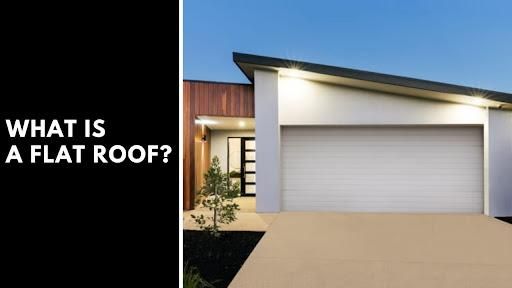A flat roof is a roof which is almost level in contrast to the many types of sloped roofs. The slope of a flat roof is typically very minimal, and sometimes flat roofs may appear to be completely level. While traditional pitched roofs are more common in residential applications, flat roofs are often used in commercial and industrial buildings.
One advantage of a flat roof is that it makes it easier to install solar panels or other types of rooftop equipment. Another advantage is that flat roofs are less susceptible to leaks and other types of damage than pitched roofs.
Types of Flat Roofs
There are four types of flat roofs:
- Built-up roofs,
- Single-ply roofs,
- Spray foam roofs, and
- Metal roofs.
The slope of a flat roof is typically very low, and sometimes the roof may even appear to be completely level. Although they are called “flat”, flat roofs are not actually 100% flat. They usually have a slight slope to allow for water drainage.
The four main types of flat roofs are built-up roofs, single-ply roofs, spray foam roofs, and metal roofs. Each type of roof has its own unique benefits and drawbacks. Built-up roofs (BURs) are the most common type of flat roof. They are made up of multiple layers of asphalt-impregnated felt or other materials, which are then covered with a top layer of gravel, asphalt, or tar.
BURs are very durable and can last up to 30 years with proper maintenance. However, they are also very heavy, which can make them difficult to install and repair. Single-ply roofs are a newer type of flat roof that consists of a single layer of material, such
Disadvantages of a flat roof
- A flat roof is a type of roofing system that has a horizontal or nearly horizontal surface.
- The term "flat" is used in reference to the plane of the roof, rather than the overall shape of the roof.
- A flat roof can be made from a variety of materials, including asphalt, metal, rubber, and various types of single-ply membranes.
- One of the most common complaints about flat roofs is that they are more prone to leaks than pitched roofs.
- While a well-maintained flat roof should not leak any more than a pitched roof, the fact that water can pool on a flat roof increases the chances that a leak will occur.
- If a flat roof does leak, the damage can be much more extensive than on a pitched roof, as water can seep into the building through cracks and seams.
- Another disadvantage of flat roofs is that they are not as effective at shedding snow and ice as pitched roofs.
- This can be a serious problem in areas that experience heavy snowfall, as the weight of the snow and ice can cause the roof to collapse.
- Flat roofs also tend to be hotter than pitched roofs, as they absorb more heat from the sun. This can be a problem in hot climates, as it can make
Advantages of a Flat roof
There are many advantages of having a flat roof on your home or office.
- One of the main advantages is the fact that they are very easy to maintain and repair. If you have a shingled roof, you will need to climb up on the roof to fix or replace any damaged shingles.
- With a flat roof, you can simply walk on the roof to access any areas that need attention.
- Another advantage of flat roofs is that they are much more economical to build than pitched roofs.
- This is because there is less material involved and the labor required is also less. Flat roofs also tend to last longer than pitched roofs, so you can expect to get more value for your money in the long run.
- One of the most popular advantages of flat roofs is that they offer a great deal of usable space.
- If you have a flat roof, you can turn it into a patio or deck area where you can enjoy the outdoors without having to worry about the pitch of the roof.
- You can also use the space for storage or to install solar panels or other energy-saving devices.
- If you live in an area with a lot of snowfall, a flat roof can be a great choice. Snow and ice can collect on pitched roofs and cause




 StableDiffusion
StableDiffusion StableDiffusion
StableDiffusion StableDiffusion
StableDiffusion Photo by
Photo by  Photo by
Photo by  Photo by
Photo by 
 Photo by
Photo by  Photo by
Photo by  Photo by
Photo by  Photo by
Photo by  Photo by
Photo by 











